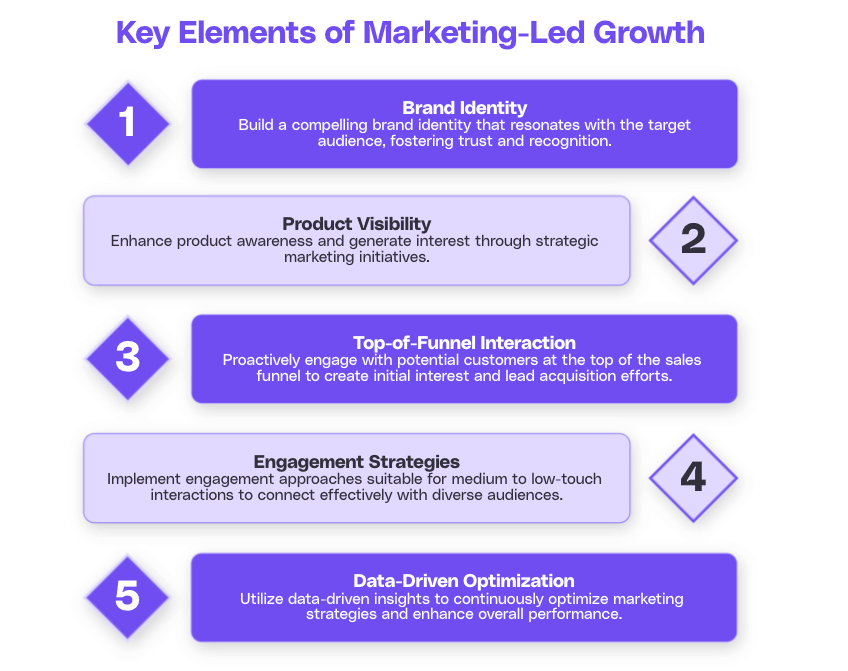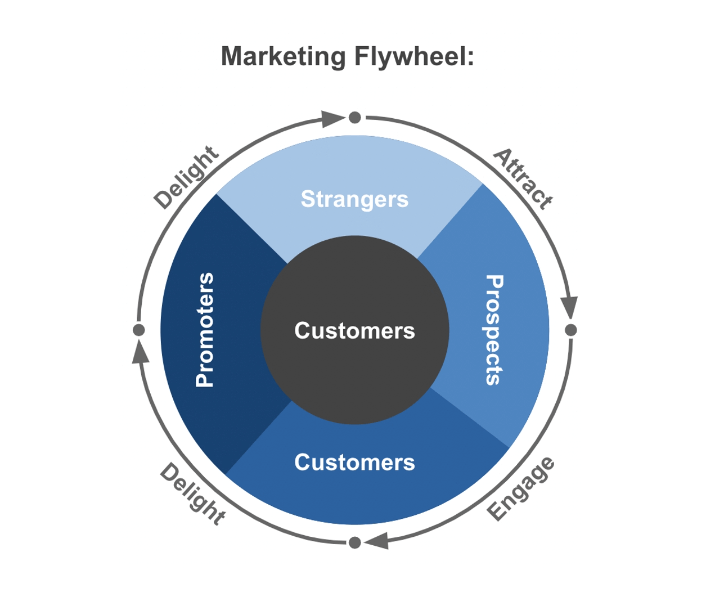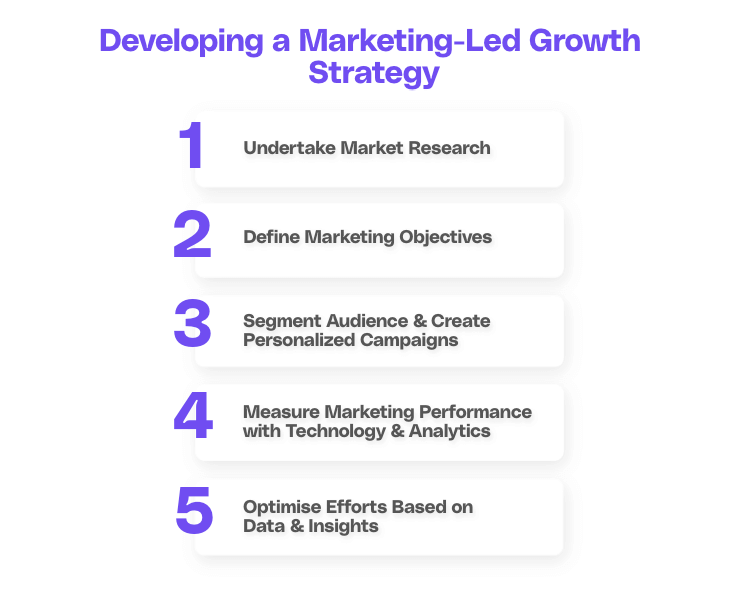Marketing-Led Growth is a strategic approach that places marketing at the forefront of a company's growth initiatives. It goes beyond traditional marketing strategies and focuses on leveraging customer-centricity, data-driven decision making, and the role of marketing as a growth driver. In this article, we will delve deeper into the concept, its principles, implementation strategies, and how to measure its success.
Understanding the concept
In order to understand Marketing-Led Growth, we must first define what it entails and explore its importance in the business landscape.
Marketing-Led Growth is not just a strategy; it is a mindset that permeates every aspect of a company's operations. It involves not only aligning marketing efforts with overall business goals but also fostering a culture of customer-centricity throughout the organization.
This means that every department, from product development to customer service, is aligned towards creating value for the customer.
Definition
Marketing-Led Growth refers to a strategy where marketing plays a central role in driving business growth. It involves aligning marketing efforts with overall business goals and utilizing marketing insights to uncover new growth opportunities.
At the core of Marketing-Led Growth is the idea of creating a seamless customer journey. This means that every touchpoint, from the first interaction with a brand to post-purchase support, is carefully crafted to provide a consistent and delightful experience for the customer.
By focusing on the customer journey, companies can not only attract new customers but also retain existing ones, leading to sustainable growth.
The importance of marketing-led growth
Marketing-Led Growth is crucial in today's highly competitive market. It enables companies to:
- Connect with their customers on a deeper level
- Deliver personalized experiences
- Build long-lasting relationships
- Adapt to changing consumer demands
- Leverage data to make informed decisions
- Drive innovation within an organization
By continuously gathering and analyzing customer feedback, companies can identify areas for improvement and develop new products or services that meet the evolving needs of their target audience.
This customer-centric approach not only fosters innovation but also ensures that companies stay ahead of the competition in a rapidly changing market.
Key principles
The success of a Marketing-Led Growth strategy hinges on embracing key principles that guide its implementation. This comprehensive approach extends beyond traditional marketing strategies, prompting a fundamental mindset shift within organizations.
Emphasizing the alignment of marketing efforts with overarching business goals and objectives, this holistic approach empowers businesses to attain sustainable growth and long-term success in today's fiercely competitive landscape.

Cultivating robust brand identity
Establishing a compelling brand identity is paramount. This involves creating a unique and resonant image that captures the essence of the business and builds a strong connection with the target audience.
Trust and recognition are cultivated through consistent messaging, visual elements, and a brand persona that aligns with the values and aspirations of the audience.
Elevating product visibility
Enhancing product visibility is essential for capturing the attention of potential customers. Strategic marketing initiatives, including targeted campaigns, content creation, and visibility in relevant channels, contribute to increased awareness.
By strategically positioning products in the market, businesses can generate interest and curiosity among their target audience.
Initiating top-of-funnel interaction
Proactively engaging potential customers at the top of the sales funnel is a crucial step. This involves creating meaningful touchpoints early in the customer journey to spark initial interest.
By providing valuable information, solving pain points, or offering engaging content, businesses lay the foundation for lead acquisition, setting the stage for a deeper relationship as customers progress through the sales funnel.
Tailored engagement strategies
Implementing tailored engagement strategies is vital for connecting effectively with diverse audiences. Recognizing that different segments of the audience may require varying levels of interaction, businesses adopt approaches suitable for medium to low-touch interactions.
This could involve personalized content, targeted communication, and relationship-building initiatives that resonate with specific customer groups.
Data-driven optimization
Utilizing data-driven insights forms the backbone of continuous optimization in marketing strategies. By leveraging analytics, businesses gather valuable information about consumer behavior, preferences, and the performance of marketing campaigns.
This data-driven approach allows for informed decision-making, helping businesses refine and optimize their marketing strategies for maximum impact and sustained success.
Marketing plays a crucial role in driving business growth, especially in a Marketing-Led Growth approach.
Marketing as a growth driver
Traditionally, marketing has been seen as a support function to sales. However, in a Marketing-Led Growth strategy, marketing takes center stage in driving growth. By effectively positioning and promoting products or services, marketing can generate demand, attract new customers, and increase brand awareness.
The marketing flywheel
The marketing flywheel emphasizes the importance of customer satisfaction and advocacy in driving sustainable growth. Its key elements include:
- Attract: The flywheel starts by attracting potential leads and customers to your business. This involves creating valuable content, utilizing social media, and other strategies to bring people into your marketing sphere and turn them from strangers into prospects.
- Engage: Once you've attracted leads, the next step is to engage with them. This involves providing a positive customer experience, addressing their needs, and maintaining open communication. Engaged prospects and leads are more likely to become satisfied customers.
- Delight: Delighting customers is a key component of the flywheel model. Satisfied customers are more likely to become promoters of your brand. This could involve exceeding their expectations, providing excellent customer service, or offering exclusive perks.
The flywheel model emphasizes that customer delight leads to increased customer advocacy and word-of-mouth referrals. Satisfied customers are more likely to recommend your products or services to others, creating a positive feedback loop that drives sustainable growth.

(Source: The Mobile Spoon)
The shift from sales-led to marketing-led strategies
With the evolution of the business landscape, there has been a notable shift away from sales-led strategies. New ones have emerged, including product-led, user-led, and marketing-led growth. The latter's evolution is due to the changing customer behaviors and the need for businesses to build meaningful relationships with their target audience. A Marketing-Led Growth approach enables companies to do so, which in turn allows them to differentiate themselves and create a competitive edge.
Implementing a marketing-led growth strategy
Implementing a Marketing-Led Growth strategy requires careful planning and execution. Here are some key steps to consider:
Key steps in developing a strategy
- Conduct thorough market research to understand the competitive landscape and customer preferences.
- Define clear marketing objectives that align with business goals.
- Segment your target audience and create personalized marketing campaigns.
- Leverage technology and analytics to track and measure marketing performance.
- Continuously optimize your marketing efforts based on data and insights.

Implementation challenges
While Marketing-Led Growth offers significant benefits, it also comes with its own set of challenges. Some common hurdles include:
- Resistance to change within the organization
- Difficulty in repositioning marketing as a growth driver
- Adapting to rapidly changing technology and digital marketing trends
Measuring success
Measuring the success of a Marketing-Led Growth strategy is crucial to understand its impact on business performance and justify its implementation.
Key performance indicators
Some key performance indicators (KPIs) to consider when measuring the success of a Marketing-Led Growth strategy include:
- Customer acquisition and retention rates
- Revenue growth and profitability
- Engagement metrics such as click-through rates and conversion rates
- Brand awareness and sentiment
- Customer lifetime value
Impact on business performance
Implementing a Marketing-Led Growth strategy can have a profound impact on a company's overall performance. It can result in increased market share, improved customer loyalty, higher revenue, and sustainable business growth.
In conclusion, Marketing-Led Growth is a strategic approach that places marketing at the forefront of driving business growth. By adopting customer-centricity, data-driven decision making, and recognizing the pivotal role of marketing, businesses can stay ahead of the competition and achieve long-term success.
Unlock your SaaS product's growth potential with Cello
Ready to transform your users into a powerful growth engine? Cello offers the simplest way to integrate a peer-to-peer referral program into your SaaS product, catalyzing your marketing-led growth strategy. With minimal development time, immediate payback, and seamless integration, Cello empowers your users to share your product effortlessly, turning their enthusiasm into your success. Experience the ease of automated rewards, real-time performance tracking, and compliance peace of mind. Witness how tl;dv achieved over 550 monthly referral signups rapidly with Cello. Embrace the future of user-led growth and book a demo to see Cello in action today.
Resources
Related Articles

Best Referral Software for SaaS with Chargebee Integration: The Definitive Guide to Revenue Attribution
The Strategic Convergence of Billing and User-Led Growth In the contemporary landscape of B2B ...

Automating Stripe Referral Tracking: A Cello Integration Guide
Scaling a referral program manually is impossible. The integration between Cello and Stripe ...

